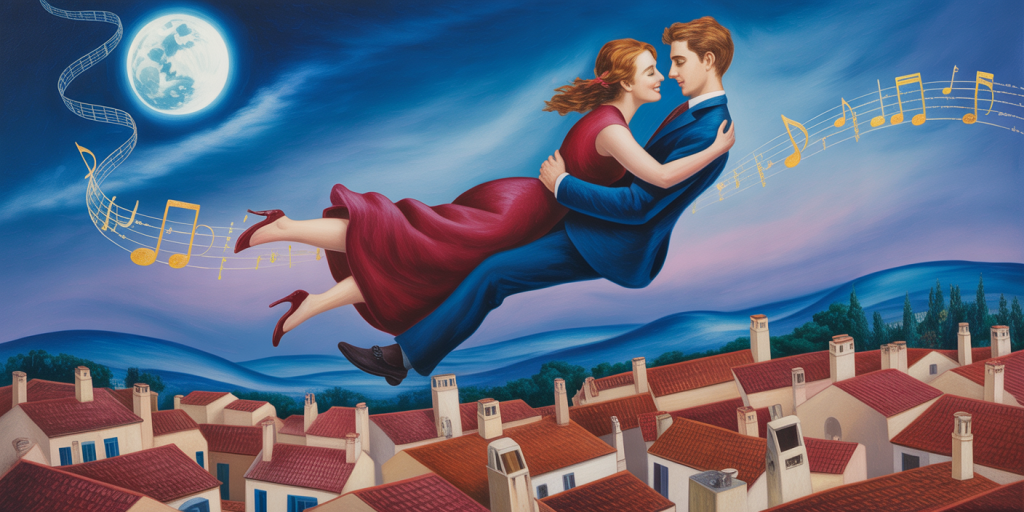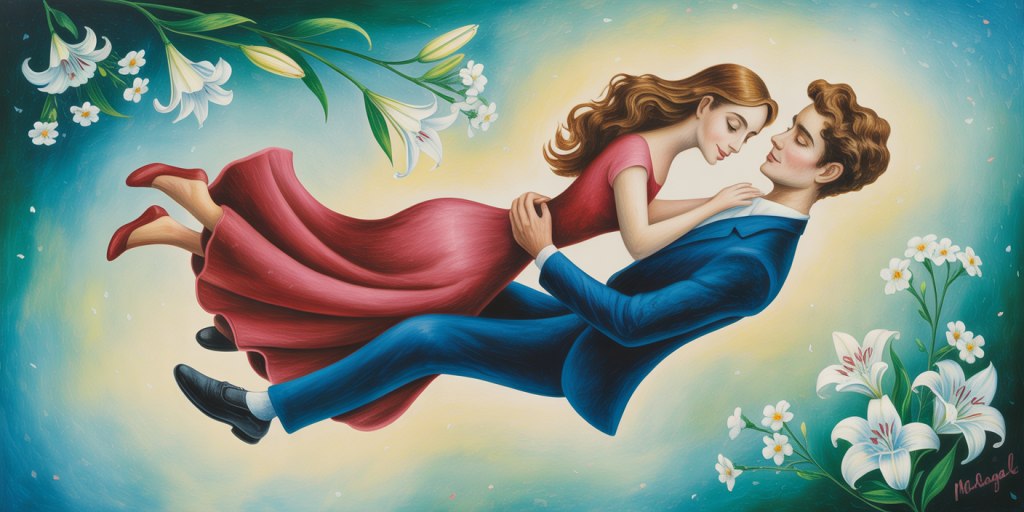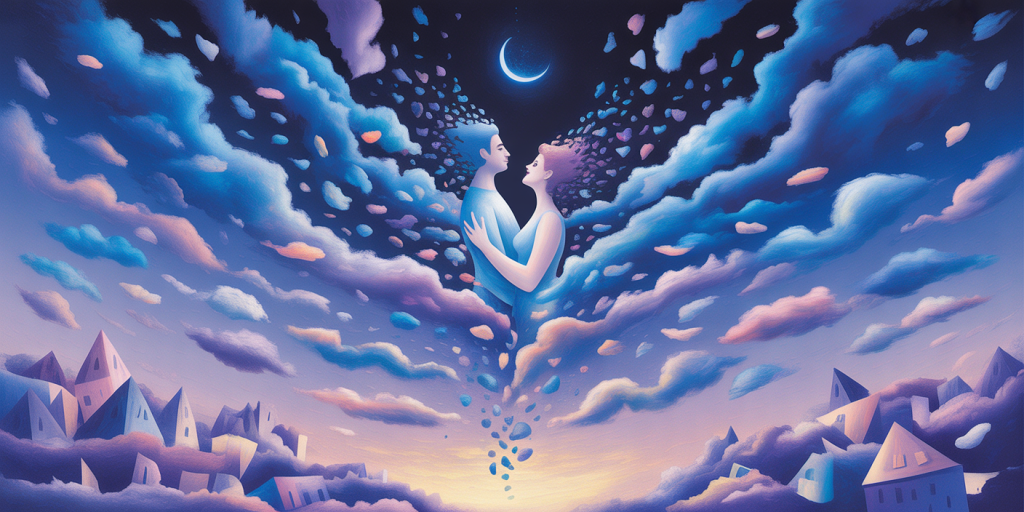The Blue Breath of Chagall and the Soul in Levitation
Some paintings do not merely depict; they ascend. They do not freeze a moment but extend it into eternity. Marc Chagall’s world is one such ascension, where houses float like memory, lovers drift above rooftops, and blue is not a color but a state of being. In his visual theology, gravity surrenders to feeling, and the soul, untethered, begins its slow, poetic flight. There is a breath in his work—a breath not taken by lungs, but by hearts.
To step into Chagall’s dream is to release yourself from chronology and certainty. His blues are not melancholy, but melodic. They carry the scent of devotion, of stars whispered into the sky by dreamers. And through this celestial palette, Chagall levitates the human soul, not to escape the world, but to elevate its ordinary beauty into the sublime.
Table of Contents
- The Blue That Breathes Beyond the Frame
- Lovers Suspended in Light
- The Gravity of Dream
- Bouquets That Refuse to Wilt
- Houses with Wings of Memory
- The Moon as Witness
- The Music of Goat and Violin
- Windows into Invisible Homes
- The Embrace Floating Above Time
- Texture of a Celestial Quilt
- Faces as Altars of Longing
- The Color of Remembering
- Animals as Keepers of Silence
- The Torah Written in Petals
- Red That Murmurs Beneath Blue
- The Weightless Suffering
- From Vitebsk to the Sky
- The Line That Dances
- Souls Wearing the Wind
- Eternity Within a Single Touch
The Blue That Breathes Beyond the Frame
Blue in Chagall is not pigment—it is breath. It exhales across the canvas, enveloping figures like a lullaby. This is not the blue of sorrow, but the blue of dreams remembered at dawn. It reaches beyond visual space, settling into the marrow of emotion.
Lovers Suspended in Light
His lovers do not stand on earth. They float, wrapped in each other’s light. Arms gently curved, eyes closed or searching, their levitation feels less magical than inevitable. Love, for Chagall, is an escape from mass, a holy act of weightlessness.

The Gravity of Dream
Dreams in Chagall’s work are heavier than reason but lighter than reality. The dream becomes its own dimension, governed by emotion. Structures bend, proportion surrenders, and light carries memory like a cradle. Dreams ground the painting more than the laws of physics.
Bouquets That Refuse to Wilt
The flowers in Chagall’s arms are not bound by seasons. They float beside faces or rise like incense. Their petals are not delicate—they are hymns. Each bouquet is a blossoming of love, remembrance, and joy eternal, woven into a garland that never fades.
Houses with Wings of Memory
His buildings are not inert. They remember, they dream. Tilted rooftops lean like old men nodding in prayer. Windows blink like eyes of grandmothers. The homes hover, as if trying to return to a childhood once lived and now painted in spectral blues.
The Moon as Witness
The moon in Chagall’s sky is no ornament. It is a sentient presence, watching with maternal silence. Sometimes it peers through a window; sometimes it crowns the night. It listens to violinists, guards sleeping towns, and whispers in silver to lovers passing by.
The Music of Goat and Violin
Music in Chagall is visual. It floats from violins held by angels or goats, curling through the canvas like invisible ribbon. The goat—sacred, rustic, absurd—plays as if every note stitches reality back together. This harmony is not heard. It is felt beneath the skin.
Windows into Invisible Homes
Windows abound in Chagall, not as architecture but as portals. Some lead into memory, others into mystery. They do not promise clarity but allow the soul to gaze inward. Light passes through them like an old letter opened in silence.
The Embrace Floating Above Time
Time stands still in Chagall’s arms. When two lovers meet in his world, they defy chronology. There is no before or after, only the eternal now of their embrace. In this levitation, even the ticking of clocks hushes itself.

Texture of a Celestial Quilt
Chagall’s paintings feel sewn rather than painted. The layers of pigment gather like woven fabric, each tone a thread in the quilt of heaven. The surface invites the touch of the soul, as if to wrap oneself in the warmth of the dream.
Faces as Altars of Longing
Every face in Chagall’s universe holds a quiet yearning. Eyes wide or lidded with tenderness, they do not look out—they call inward. Each portrait becomes a prayer, and each expression, an altar where memory burns like a candle.
The Color of Remembering
Color in Chagall is not illustrative—it is emotional transcription. Blue does not describe the sky, but the memory of a lullaby. Red is not fire, but heartache and celebration entangled. Yellow flickers like Sabbath candles in childhood kitchens.
Animals as Keepers of Silence
The animal companions in Chagall’s paintings do not explain themselves. They stare back, enigmatic and calm, guardians of the surreal. The cow, the donkey, the rooster—each bears witness to a world that drifts like incense between waking and wonder.
The Torah Written in Petals
For Chagall, the sacred was never confined to scrolls. It lived in trees, kisses, stars. The presence of Jewish rituals and symbols in his work glows quietly. Candlesticks levitate beside brides. Angels hum in Hebrew. Petals fall like holy script from unseen hands.
Red That Murmurs Beneath Blue
Often beneath his oceanic blues, a pulse of red whispers. A sleeve, a ribbon, a bouquet, a heart. This interplay is not opposition, but balance. Red does not disrupt the dream; it roots it, giving the levitation its blood.
The Weightless Suffering
Even sorrow in Chagall seems to float. Figures weep in the air, draped not in despair but translucence. Their pain is not erased, but gently held aloft, as if suffering too has the right to rise above the noise of earth.
From Vitebsk to the Sky
Chagall’s hometown of Vitebsk appears like a recurring lullaby. Its crooked fences, tiny churches, and sleeping roofs echo in his paintings like a name spoken in dreams. The town becomes not a location, but a launching point for flight.
The Line That Dances
Chagall’s line is never rigid. It sways, twirls, caresses the form like a dancer. Outlines do not confine but celebrate the freedom of movement. Figures flow into one another, into landscape, into song. It is drawing as choreography.
Souls Wearing the Wind
Wind is not seen in Chagall, but felt in every motion. His characters are wrapped in its whisper, carried not by muscle but by memory and spirit. The soul, in his vision, wears the wind like a second skin—invisible, palpable.

Eternity Within a Single Touch
When hands meet in Chagall’s universe, the universe holds its breath. Fingers brush, palms press, and time folds inward. The tenderness of the gesture does not belong to a moment—it belongs to forever. Each touch is an act of faith.
FAQ
Who was Marc Chagall?
Marc Chagall (1887–1985) was a Belarusian-French artist whose work blended folklore, religion, fantasy, and vibrant color. Deeply influenced by his Jewish heritage and his memories of Vitebsk, he created a world where dreams and reality entwined.
What is meant by “levitating figures” in Chagall’s art?
Many of Chagall’s subjects float in mid-air, symbolizing love, transcendence, and spiritual freedom. It reflects his emotional connection to memory, belief, and the surreal.
Why is blue so prominent in Chagall’s work?
Blue represents peace, dreams, and emotional depth in Chagall’s palette. It evokes the infinite, the sacred, and the internal world of longing and reflection.
What role does music play in Chagall’s paintings?
Music, especially violins and singing, often appears in his work, symbolizing cultural memory, love, and the invisible harmonies of life.
How does Chagall incorporate Jewish imagery?
Chagall includes synagogues, Torah scrolls, Sabbath candles, and Hebrew letters in his works, often floating among secular symbols. He merges the sacred and the everyday.
Final Reflections: When the Soul Takes Flight in Blue
To gaze upon Chagall is to remember what we forgot: that love is lighter than gravity, that sorrow can shimmer, that blue is not sadness but ascension. His world is not an escape but a revelation—a place where the mundane becomes divine, where rooftops bend for lovers, and where dreams do not end but begin with color.
In Chagall’s breath of blue, we find the sky within ourselves. And in that levitating soul, we see our own desire to be held, to remember, to float—not away from life, but deeper into its beauty.
